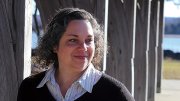“This might be a little in the weeds, but trust me, it’s cool.” Heather Henriksen is warming up an impassioned (but definitely cool) oration about a University-wide push to get harmful chemicals—“flame retardants, antimicrobials, stain repellents, water repellents”—out of campus buildings. “I’m a bit obsessed with this.” It’s her job to be: Henriksen directs the Office for Sustainability, a post she took in 2008, a few months after the office formed as a successor to the Harvard Green Campus Initiative. Among her tasks: shepherding into existence Harvard’s five-year Sustainability Plan, a wide-ranging “road map” for enhancing well-being and reducing the University’s overall environmental footprint by 2020. The campus, she says, is “an excellent test bed” for solutions: “If we can pilot and prove it here, we can scale it” to the world beyond. “That’s the real goal.” A child of northern California, Henriksen grew up hiking, biking, and volunteering for beach cleanups. “I was the kid who was reading the Berkeley Wellness letter.” She interned one summer with Save the Bay, removing mercury pollution from the San Francisco Bay—and would discover 10 years later that her own mercury levels had skyrocketed from eating fish. “That’s when I said, ‘OK, this environmental work isn’t casual anymore.’” Before coming to Harvard as a Kennedy School student (she’s M.P.A. ’08), she worked for five years in business development for Time Warner in New York; she spent her off-hours two blocks away at the National Resources Defense Council, listening, learning, working. These days Henriksen spends her nights with her two-year-old daughter, Liv, whose name means “life” in Danish. “She reminds me why we’re doing all this.”
Meet Heather Henriksen, director of the Harvard Office for Sustainability
Meet Heather Henriksen, director of the Harvard Office for Sustainability
Harvard’s chief sustainability officer on scaling up green solutions while scaling back its environmental footprint

Photograph by Stu Rosner
You might also like
Mount Vernon, Historic Preservation, and American Politics
Anne Neal Petri promotes George Washington and historic literacy.
Landscape Architect Julie Bargmann Transforming Forgotten Urban Sites
Julie Bargmann and her D.I.R.T. Studio give new life to abandoned mines, car plants, and more.
Preserving the History of Jim Crow Era Safe Havens
Architectural historian Catherine Zipf is building a database of Green Book sites.
Most popular
Explore More From Current Issue

Novelist Lev Grossman on Why Fantasy Isn’t About Escapism
The Magicians author discusses his influences, from Harvard to King Arthur to Tolkien.

The 1884 Cannibalism-at-Sea Case That Still Has Harvard Talking
The Queen v. Dudley and Stephens changed the course of legal history. Here’s why it’s been fodder for countless classroom debates.

On Weekends, These Harvard Math Professors Teach the Smaller Set
At Cambridge Math Circle, faculty and alumni share puzzles, riddles, and joy.





